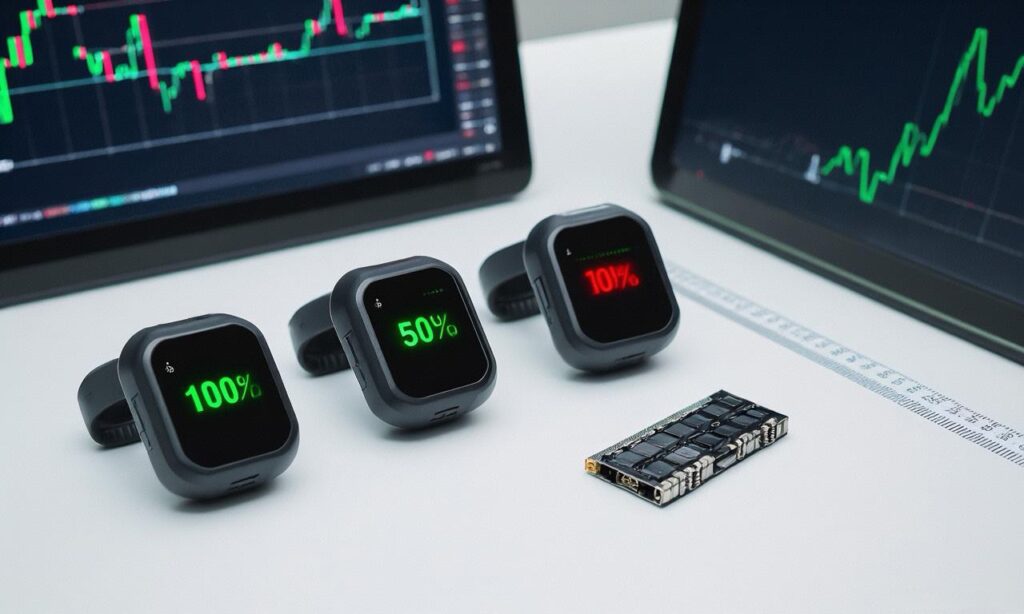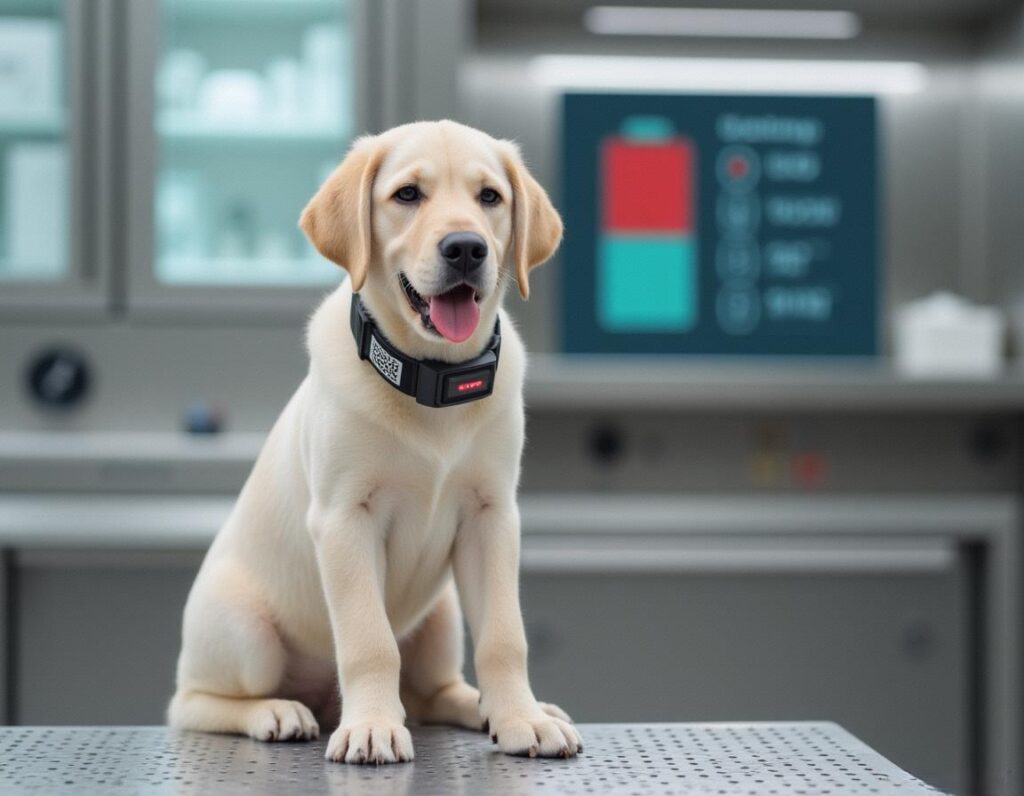Introduction
Pet GPS trackers have become essential tools for any pet owner wanting to keep tabs on their furry friends, offering peace of mind and enhancing pet safety. However, one crucial aspect of these devices is the battery life, as frequent recharging can disrupt the tracking process when you need it most. In this blog, we’ll explore the factors affecting the battery life of pet GPS trackers, why simply opting for a bigger battery isn’t always the best solution, and practical tips to extend your device’s runtime while ensuring safe usage. So, let’s dive in and learn how to maximize the efficiency of your pet’s GPS tracker!
Key Factors Affecting Battery Life of Pet GPS Trackers

Let’s dive into the nuts and bolts of what affects the battery life of your pet’s GPS device. Understanding these factors will not only explain why your device lasts as long (or as short) as it does but can also help you make smarter choices to extend its lifespan.
Battery Size and Capacity
Battery capacity, usually measured in milliamp hours (mAh), plays a straightforward role in how long a GPS tracker can run before needing a recharge. Larger capacity batteries can hold more power, naturally leading to longer runtimes. However, this isn’t a free pass to select the biggest battery you can find. Increasing battery size often results in a heavier device, which can make it uncomfortable for your pet to wear. Striking the right balance between battery capacity and the device’s weight is crucial for a happy, tail-wagging pet.
Positioning Frequency
The frequency at which your pet’s GPS sends location updates significantly impacts power consumption. A device that updates your pet’s location every few minutes will drain the battery much faster than one that updates every hour or so. The more often a position is relayed, the more power is used, which means frequent updates are great for tracking hyperactive furballs but not so much for keeping your device alive all day. Finding a configuration that fits your pet’s activity level and your peace of mind is key.
Signal Strength and Connectivity
Signal strength can be a silent battery drainer. When your pet wanders into areas with weak GPS or cellular signals, the device uses more battery power trying to maintain a reliable connection. It’s like trying to shout from a distance versus talking face-to-face—it simply requires more energy. To mitigate excessive battery drain, consider how areas with poor reception might impact your device’s battery life, and if possible, set alerts to inform you when signal loss occurs.
Device Hardware and Power Efficiency
Not all pet GPS devices are created equal when it comes to power efficiency. Some devices boast advanced chipsets, optimized circuit designs, and firmware that conserves battery power. Opting for a device with energy-efficient hardware can stretch battery life significantly, meaning fewer recharges and more time for your pet to explore. Choosing such optimized hardware is another layer of strategy in extending battery lifespan without sacrificing your pet’s safety.
Environmental Temperature
Temperature is another factor that can influence how your GPS tracker’s battery performs. Extremely cold or hot environments can cause the battery to deplete faster than normal. In colder temperatures, batteries lose capacity; in hotter conditions, they degrade quicker. Make sure to take seasonal shifts into consideration—perhaps giving your pet’s collar a break during peak temperature swings to avoid rapid battery drain.
Battery Aging and Usage Cycles
Like all rechargeable batteries, the ones in pet GPS trackers are subject to aging. Over time, after going through numerous charge and discharge cycles, the battery’s capacity starts to diminish, leading to shorter run times. It’s a natural occurrence, but being mindful of your charging habits can slow down this process. For example, avoiding letting the battery drain completely before charging and not overcharging can prolong the battery’s lifecycle.
Additional Features Impacting Battery Life
While it’s tempting to have a device packed with features like voice calls, alerts, or Bluetooth compatibility, each of these extras draws additional power. Balancing these convenient features with their impact on battery life is important. Customize your device settings to align with what’s necessary for your tracking needs, and disable or limit the use of unnecessary functions to conserve power.
Why You Can’t Just Use a Bigger Battery
Once you understand the basic factors affecting battery life, it might be tempting to think that simply using a bigger battery would solve all your problems. But it turns out, things are not so simple.

Size and Weight Constraints
The most obvious limitation comes down to the trade-offs between size, weight, and comfort. Larger batteries mean bulkier and heavier devices, which can become uncomfortable for your pet to wear, particularly for smaller animals. Ensuring that your pet remains at ease while wearing a tracking device is crucial for it to serve its purpose effectively.
Battery Technology Limitations
Different battery technologies, like lithium-ion or nickel-metal hydride (NiMH), have different energy densities. While some can pack a lot of power in a small size, they can be more expensive or difficult to source in larger capacities for compact devices like pet trackers. Thus, technological constraints limit the feasibility of just scaling up battery size.
Design and Cost Considerations
From a design and cost perspective, larger batteries mean new design schematics and potentially higher production costs, which could push up the retail price. These added expenses might make the product less competitive in the market. Therefore, manufacturers aim to create devices that balance cost with functionality and comfort, without simply opting for bigger batteries.
In upcoming sections, we’ll explore practical tips and everyday strategies to effectively extend your pet GPS tracker’s battery life without negatively impacting device performance or pet comfort.
Practical Ways to Extend Pet GPS Battery Life
Let’s get into the nitty-gritty of how to keep your pet GPS running smoothly. Extending the battery life of your pet GPS device is crucial not only for peace of mind but also for your pet’s safety. While you might think a bigger battery is the automatic solution, it ain’t always the case. Here are some practical tips to help you maximize battery efficiency and keep tabs on your furry friend without constantly worrying about recharging.
Choosing the Right Operating Mode
One of the most impactful ways to extend your pet GPS battery life is by choosing the right operating mode. Many GPS devices offer different modes such as “power-saving” or “eco” mode. These settings reduce power consumption by adjusting how frequently the device sends location updates. If your pet is safely lounging at home, frequent updates might not be necessary. Switching to a less active mode can significantly prolong battery life.
– Power-Saving Mode: Use this when your pet is in safe areas or when you don’t need constant monitoring.
– Active Mode: Perfect for when your pet is out and active, ensuring you receive more frequent updates.
By getting familiar with these modes and using them according to your needs, you can ensure that the battery goes the extra mile.
Proper Charging Habits
Charging habits greatly impact battery longevity. It’s not just about plugging in whenever the battery runs low; it’s about intelligent charging practices:
– Avoid Deep Discharge: Try not to let your device’s battery drain completely. This can shorten its overall lifespan.
– Optimal Charging Ranges: Aim to keep the battery level between 20% and 80%. This range helps prevent stress on the battery, thus maintaining its health over the long term.
When practicing these charging habits, you’re not just extending the runtime per charge but also boosting the overall lifespan of your battery.
Disabling Unnecessary Features
Many GPS trackers come jam-packed with features. While they can be super handy, they also consume extra battery power. Features such as voice interaction or continuous activity tracking can drain your device faster than necessary. Instead of keeping everything on by default, consider:
– Turning Off Rarely Used Features: If certain functionalities aren’t essential, it’s wise to disable them to conserve energy.
– Customizing Settings: Tweak the settings to minimize turning on non-essential features, especially those that require GPS or cellular data frequently.
By prioritizing what features are active, you’ll optimize battery usage without compromising on safety.
Environmental Care
Environmental factors, like temperature, play a significant role in battery performance. Extreme temperatures—either hot or cold—can drain the battery faster or even cause lasting damage. Here’s what you can do:
– Avoid Extreme Temperatures: Keep your device within a moderate temperature range when possible.
– Seasonal Storage: During extreme weather conditions, consider storing the device inside when not in use.
These small yet significant practices will ensure the device stays functional longer, giving both you and your pet more peace of mind.
Battery Transport Safety Considerations
 Image courtesy: Unsplash
Image courtesy: Unsplash
Keeping your pet GPS battery not just functional but also safe during transport is just as crucial. Accidents can happen, and batteries can be hazardous if not handled properly. Let’s explore how to prevent mishaps and ensure maximum safety.
Protection Against Shock and Vibration
When it comes to transporting your GPS device or its batteries, securing your device properly can prevent damage:
– Secure Packaging: Use bubble wrap or cushioning materials to absorb shocks during transport.
– Sturdy Containers: Consider a hard-shell case for additional protection against impacts or drops.
Taking these precautions minimizes the risk of harm from mechanical stress, preserving battery integrity and functionality.
Moisture and Water Resistance
Moisture can spell doom for electronic devices like GPS trackers. Water ingress can cause short circuits and damage batteries.
– Waterproof Casings: If possible, invest in waterproof packaging when transporting or storing your GPS device.
– Dry Storage Areas: Keep stored batteries and devices in a cool, dry place to prevent moisture buildup.
Being mindful of these practices ensures that your batteries remain safe and functional regardless of the environment they encounter.
Preventing Short Circuits
Short circuits are a severe risk in any electronic device, particularly during transport or storage. Proper precautions can mitigate this danger:
– Insulation: Ensure battery terminals are well-insulated to avoid any accidental contact with conductive materials.
– Separation: Store batteries separately to prevent them from touching each other or other conductive elements.
These strategies will prevent short circuits, preserving both the safety and longevity of your GPS batteries.
Proper Labeling and Compliance
Last but certainly not least is the importance of proper labeling and compliance when handling or transporting batteries.
– Hazard Markings: Follow regulations for labeling batteries with the necessary hazard symbols and statements.
– Documentation: Keep necessary documentation on hand to show compliance with transportation safety laws and regulations.
By ensuring adherence to these guidelines, you can transport and handle your batteries safely and legally, protecting both your pet and the broader environment.
By embracing these practical strategies, extending the battery life of your pet GPS tracker becomes much more feasible. From optimizing operational settings to ensuring safe battery transport, each action contributes to a more reliable and lasting solution. Whether you’re at home or on the go, your pet’s safety and your peace of mind remain intact.
Conclusion
Pet GPS trackers are a vital tool for ensuring your furry friend’s safety while giving you peace of mind. Battery life is a critical feature of these devices, as a dead battery means losing track of your pet. By understanding the factors that affect battery life, including battery size, positioning frequency, and signal strength, pet owners can make informed choices to keep devices optimally running.
Remember, opting for a bigger battery isn’t always the solution due to the implications on device weight and comfort. Instead, focus on practical ways to extend battery life, such as switching to power-saving modes when constant tracking isn’t necessary, adopting healthier charging habits, and disabling unnecessary features. Additionally, always handle and transport batteries safely to prevent damage that could affect performance.
By applying these tips, you can ensure your pet’s GPS device has a longer run time, safely keeping your beloved companion connected and secure.
Explore more details about Pet PS tracker here: Astute Inno GPS Tracker








